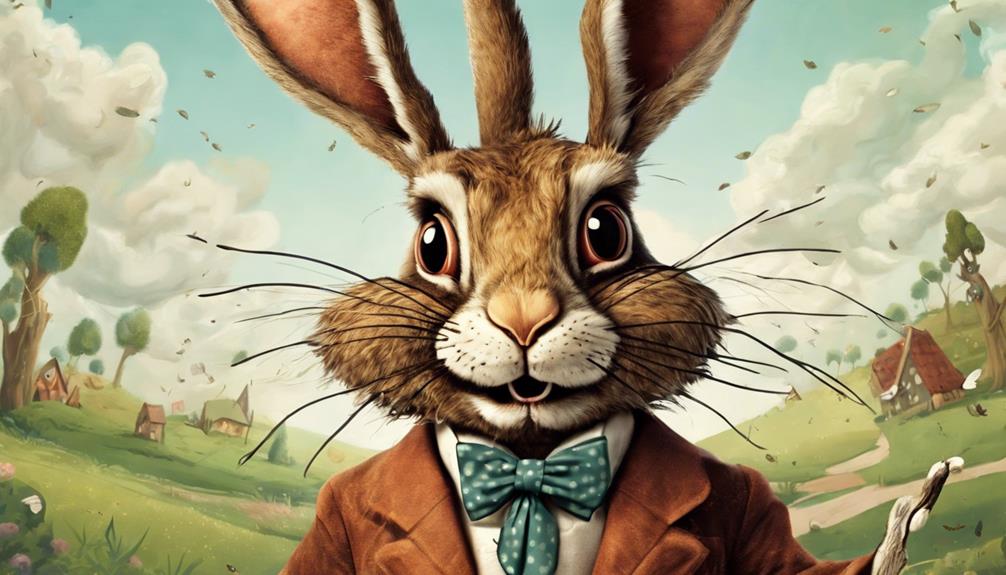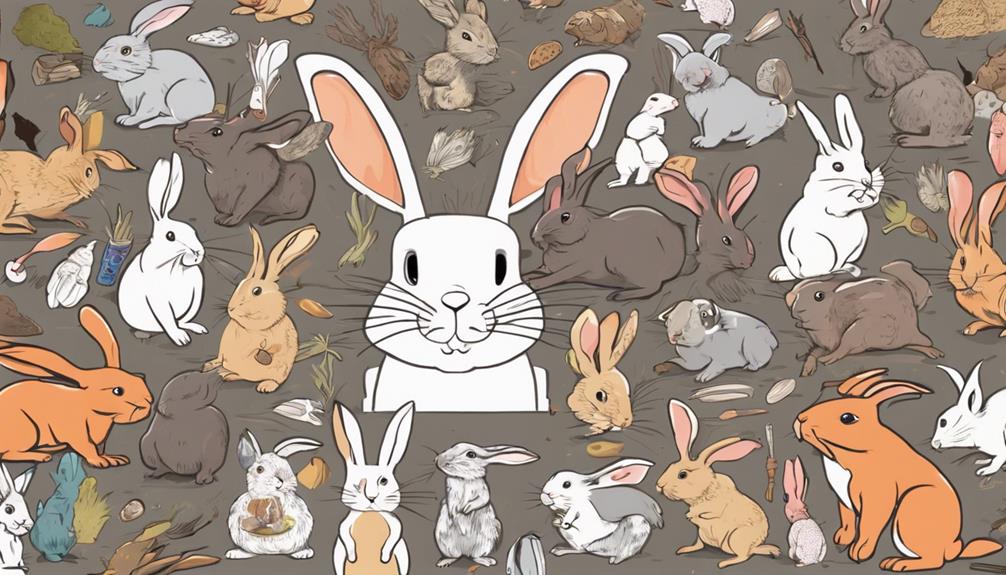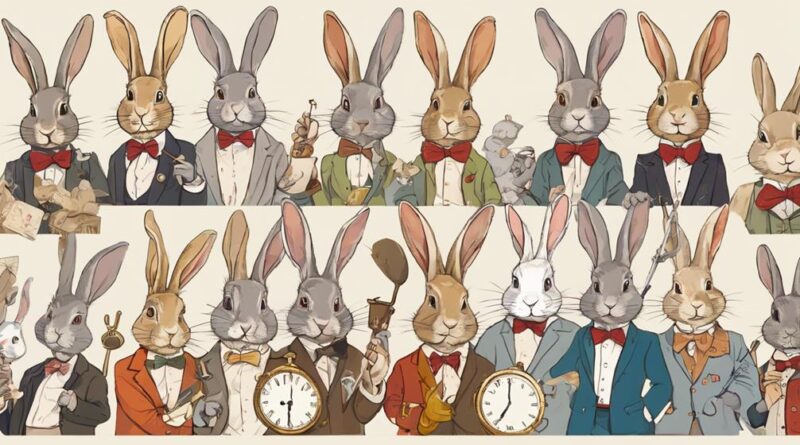Top 10 Popular Rabbit Myths in Pop Culture
You've probably heard some rabbit myths in pop culture, but let's set the record straight on the top 10. The Easter Bunny actually has origins in German folklore and isn't laying eggs. Bugs Bunny charms with wit, sarcasm, and resilience, despite not laying eggs either. Forget lucky rabbit's foot – it's a superstition that harms rabbits and modern knowledge debunks it. Wondering about rabbit foot luck? Stemming from ancient beliefs in magical rabbits, it raises ethical concerns today. Curious about more surprising rabbit myths in pop culture? Keep exploring for fascinating insights into these beloved furry creatures.
The Easter Bunny's Origins
The origins of the Easter Bunny can be traced back to German folklore and pagan traditions. Easter traditions have evolved over centuries, blending Christian beliefs with ancient customs. In German folklore, there was a tale of an 'Osterhase,' a hare that laid colored eggs for children to find during the Easter season. This bunny folklore became intertwined with Easter celebrations, symbolizing fertility, new life, and rebirth.
Legends surrounding the Easter Bunny spread throughout Europe, with different regions adding their own twists to the story. In some areas, the Easter Bunny was believed to judge children's behavior, much like Santa Claus does at Christmas. Good children would receive treats and colored eggs, while naughty ones might get pranks or no gifts at all.
The concept of the Easter Bunny made its way to the United States in the 1700s, brought over by German immigrants. Over time, the bunny became a central figure in American Easter traditions, hopping around delivering baskets filled with candies, eggs, and toys to children.
Understanding the origins of the Easter Bunny sheds light on how bunny folklore and legends have been passed down through generations, shaping the way we celebrate Easter today. The colorful eggs, the joy of hunting for hidden treats, and the whimsical charm of the Easter Bunny all contribute to the magic of this springtime holiday.
Bugs Bunny's Personality
Bugs Bunny's iconic personality shines through as a blend of wit, charm, and mischievous antics in the world of animated entertainment. Created by Warner Bros., Bugs Bunny made his debut in the 1940s and quickly became one of the most beloved characters in animation history. Through various animated portrayals, Bugs Bunny's character has evolved, but certain traits have remained consistent, contributing to his enduring popularity.
In his animated portrayals, Bugs Bunny is known for his quick-thinking, sarcastic humor, and nonchalant attitude, often outsmarting his foes with ease. His catchphrase 'What's up, Doc?' has become synonymous with his character and is instantly recognizable to audiences worldwide. Bugs Bunny's cultural perceptions have varied over time, with some viewing him as a symbol of cleverness and resilience, while others see him as embodying a rebellious spirit against authority figures.
Despite being a trickster at heart, Bugs Bunny is also portrayed as caring and brave, standing up for his friends and always coming out on top in the face of adversity. His character has transcended generations, appealing to both children and adults alike, making him a timeless figure in the realm of animation. Bugs Bunny's enduring charm lies in his ability to entertain and inspire audiences with his unique blend of humor and personality.
Rabbits Lay Eggs

Contrary to popular belief, rabbits don't lay eggs as part of their reproductive process. Bunny reproduction is often misunderstood, leading to the perpetuation of egg laying myths. Rabbits are mammals, and like all mammals, they give birth to live young. Let's delve into the fascinating world of bunny reproduction to debunk this common misconception.
Rabbits are known for their rapid breeding habits, with females capable of producing multiple litters each year. A doe (female rabbit) typically has a gestation period of around 28-31 days before giving birth to a litter of adorable baby bunnies, known as kits. These kits are born hairless, blind, and entirely dependent on their mother for nourishment and care.
The confusion surrounding rabbits laying eggs may have stemmed from the association between rabbits and Easter. The tradition of the Easter Bunny, who delivers eggs and treats to children, may have led to the misconception that rabbits lay eggs. In reality, the Easter Bunny is a fictional character, and rabbits don't lay eggs in the same way that birds or reptiles do.
Lucky Rabbit's Foot
Misconceptions about rabbits extend beyond their reproductive habits, such as the belief in the superstition surrounding the lucky rabbit's foot. While it's a common notion that carrying a rabbit's foot brings good luck, the truth behind this practice might surprise you.
Rabbit anatomy plays a crucial role in debunking this superstition. The lucky charm associated with a rabbit's foot is usually the hind leg, particularly the left one. However, rabbits use their powerful hind legs for hopping and balance, making them an essential part of their anatomy. In reality, removing a rabbit's foot for superstitious reasons would be harmful and cruel to the animal.
Superstitions surrounding the lucky rabbit's foot have been around for centuries, but modern understanding has shed light on the truth. It's essential to respect animals and their well-being rather than perpetuate myths that harm them. Instead of relying on superstitions, appreciating rabbits for their unique characteristics and behaviors can be a more fulfilling way to connect with these fascinating creatures.
Next time you come across the idea of a lucky rabbit's foot, remember the importance of respecting animals and understanding the reality behind such beliefs. Rabbit anatomy and the debunking of superstitions reveal a deeper truth that encourages compassion and knowledge over outdated myths.
Rabbit Foot for Good Luck
Considering the historical context and cultural significance, carrying a rabbit's foot for good luck has been a practice that dates back centuries. The idea of using rabbit feet as good luck charms stems from ancient Celtic and African folklore, where rabbits were seen as magical creatures capable of warding off evil spirits. This superstition eventually made its way into Western culture, where it became a common belief that carrying a rabbit's foot could bring good fortune and protect against misfortune.
The practice of using rabbit feet as talismans for good luck is deeply rooted in rabbit folklore. Rabbits have long been associated with fertility, abundance, and luck in various cultures. In some Native American traditions, rabbits are seen as symbols of good fortune and success. This belief in the luck-bringing properties of rabbit feet has persisted over time and has become a popular superstition in modern society.
Despite its widespread popularity, the use of rabbit feet as good luck charms has garnered some controversy due to ethical concerns about animal cruelty. Many organizations and individuals advocate against the use of real rabbit feet for superstitious purposes, promoting alternative charms or synthetic replicas instead. While the tradition of carrying a rabbit's foot for good luck continues for some, it's essential to consider the ethical implications and respect the welfare of animals in the process.
Rabbits Love Carrots
Rabbits' affinity for carrots is a well-known aspect of their dietary habits, often portrayed in popular culture as a staple food choice for these furry creatures. While it's true that rabbits enjoy carrots, it's important to understand that their dietary preferences go beyond this orange vegetable. Carrots are high in sugar and should be fed to rabbits in moderation to prevent health issues like obesity and dental problems. The bulk of a rabbit's diet should consist of hay, fresh vegetables, and a small amount of pellets to ensure they receive a balanced nutrition.
In terms of rabbit behavior, training, offering carrots as treats can be a useful tool. Carrots can be a great incentive for positive reinforcement during training sessions. However, it's crucial to remember that not all rabbits have the same preferences. Some rabbits may not be as fond of carrots as others and may prefer different fruits or vegetables. Understanding your rabbit's individual likes and dislikes will help in training and bonding with your furry friend.
Mad March Hare

During the spring season, the Mad March Hare phenomenon captures the attention of many curious observers. This peculiar behavior of hares has been a subject of fascination for centuries, leading to various March Hare myths and rabbit folklore.
- Aggressive Courtship: Contrary to the docile image of rabbits, male hares can engage in intense boxing matches during the breeding season. This behavior is often mistaken for aggression but is primarily a way for males to compete for the attention of females.
- Nocturnal Activity: Hares are known to be more active at night, leading to the misconception that they're exclusively nocturnal creatures. However, during the breeding season in March, they may exhibit erratic behavior during daylight hours, adding to their mysterious allure.
- Folklore and Symbolism: The Mad March Hare has been a prominent figure in folklore, symbolizing fertility, rebirth, and the coming of spring in various cultures around the world. Its association with the changing seasons has made it a popular motif in literature and art.
- Myth of Madness: The term 'Mad as a March Hare' originates from Lewis Carroll's 'Alice's Adventures in Wonderland,' where the March Hare, known for its eccentric behavior, hosts an eternal tea party. This portrayal has contributed to the belief that hares act erratically during March.
Playboy Bunny Symbolism
The symbolic significance of the Playboy Bunny transcends mere representation, delving into cultural iconography and societal perceptions. The Playboy Bunny symbol, with its origins dating back to the 1950s, is a classic emblem of allure and sophistication. The Bunny costume, meticulously designed by Hugh Hefner, founder of Playboy Enterprises, combines elements of bunny fashion with rabbit symbolism to create a distinctive and recognizable look.
Bunny fashion, characterized by the iconic satin corset, bunny ears, fluffy tail, and bow tie, encapsulates a blend of playful innocence and seductive charm. This unique style has become synonymous with the Playboy brand and is instantly recognizable worldwide. The Playboy Bunny symbolizes empowerment and confidence, embracing both the playful nature of bunnies and the allure of the unknown.
Rabbit symbolism further enhances the complexity of the Playboy Bunny emblem. Rabbits are often associated with fertility, abundance, and renewal. In the context of the Playboy Bunny, these symbols take on a modern twist, representing freedom of expression and breaking societal norms. The Playboy Bunny symbol challenges traditional perceptions of femininity and empowers individuals to embrace their sensuality with confidence.
Rabbits Are Rodents

Often misclassified due to certain similarities in appearance and behavior, rabbits aren't rodents but belong to a separate taxonomic group known as lagomorphs. This misconception stems from shared features like long incisors and a tendency to gnaw on objects. However, there are distinct differences between rabbits and rodents that set them apart.
Here are some key points to help clarify this misconception:
- Dental Formula: Rabbits have four upper incisors, unlike rodents that have only two. This unique dental structure is a clear distinguishing feature between the two groups.
- Hindgut Digestion: Rabbits have a unique digestive system that includes a large cecum where fiber is broken down with the help of beneficial bacteria. Rodents, on the other hand, have a simpler digestive system.
- Sociability: Rabbits are social animals that thrive in the company of their own kind. They form complex social structures and communicate through various behaviors. Rodents, while some are social, don't exhibit the same level of intricate social behaviors seen in rabbits.
- Dietary Differences: While both rabbits and rodents are herbivores, rabbits have a more specialized diet that includes a high proportion of hay and grass. Rodents, on the other hand, may have a more varied diet that includes seeds, nuts, and fruits.
Understanding these distinctions can help dispel the myth that rabbits are rodents, highlighting the unique characteristics of these fascinating lagomorphs.
Rabbit's Foot for Magic
Misconceptions surrounding rabbits extend beyond their classification, with the rabbit's foot often being associated with magic and superstition in popular culture. The belief in the rabbit's foot as a talisman with magical properties has roots in superstition and folklore. This tradition dates back centuries and is grounded in the idea that carrying a rabbit's foot can bring good luck and ward off evil spirits.
In traditional beliefs, it was thought that the left hind foot of a rabbit was the most powerful and held the most luck. The rabbit's foot was often dried out and carried as an amulet or charm. This practice was especially prevalent in African American folk magic and hoodoo traditions, where the rabbit's foot was believed to protect against curses and bring prosperity.
The rabbit's foot superstition gained further popularity in the early 20th century when it became a common lucky charm in Western culture. Many people would keep a rabbit's foot on their person or in their home to attract good fortune. However, it's important to note that this belief has no scientific basis and is purely based on cultural beliefs and superstitions.
While the rabbit's foot for magic remains a prevalent symbol in popular culture, it's essential to understand its origins in superstition and folklore. Whether you view it as a charming tradition or dismiss it as a mere superstition, the rabbit's foot continues to intrigue and captivate many with its mystical allure.
Frequently Asked Questions
Do Rabbits Really Lay Eggs Like the Easter Bunny?
No, rabbits don't lay eggs like the Easter bunny. The Easter bunny myth of laying eggs is a popular misconception.
In reality, rabbits are mammals and give birth to live young ones. The association of rabbits with Easter and eggs is a cultural tradition that has been passed down over time.
It's important to differentiate between myths and reality when it comes to animal biology and folklore.
Why Are Rabbit Feet Considered Lucky Charms?
Rabbit feet are seen as lucky charms due to rabbit folklore and superstitions. Throughout history, many cultures believed that rabbit's feet could ward off evil spirits, bring good luck, and provide protection.
This belief likely stems from the rabbit's reputation as a clever and swift animal, traits that people wanted to embody for success and protection. The tradition of carrying rabbit feet for luck has become a common cultural belief in various societies.
Are Rabbits Really Rodents?
Rabbits aren't rodents. They belong to the lagomorph family, not the rodent family.
As pets, rabbits exhibit unique behaviors like thumping their hind legs to signal danger or annoyance. Understanding these behaviors is crucial for proper rabbit care.
Their cute appearance and social nature make them popular pets, but remember, they aren't rodents. Be sure to provide them with a suitable environment and plenty of love and attention.
Is the Playboy Bunny Symbol Related to Real Rabbits?
The Playboy bunny symbol isn't directly related to real rabbits, but rather a cultural symbol associated with the Playboy association. Bunnies, in this context, represent a certain allure and sophistication.
The Playboy bunny logo has become iconic in pop culture, embodying a specific lifestyle and image. It's a prime example of how rabbits, as symbols, can be used to convey various meanings beyond their literal representation.
How Is a Rabbit's Foot Used for Magic?
To incorporate a rabbit's foot in magic rituals, it's believed to bring good luck and protection due to superstition beliefs. The foot is usually dried, often painted or decorated, and carried as a talisman.
Many cultures view the rabbit's foot as a powerful charm against evil spirits and bad omens. Its use in magic practices stems from ancient folklore and continues to be a common symbol in various mystical traditions.
Conclusion
In conclusion, these popular rabbit myths in pop culture have been ingrained in our society for years. From the origins of the Easter Bunny to the misconception of rabbits laying eggs, these myths have shaped our perceptions of these furry creatures.
It's important to separate fact from fiction and recognize that many of these myths are simply for entertainment or symbolism purposes. So next time you hear a rabbit myth, take a moment to consider the truth behind it.
